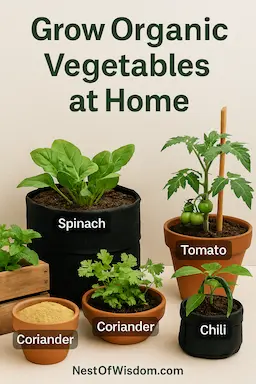

Grow organic vegetables at home even with a tiny balcony or bright window ledge. With smart containers, a simple soil recipe, and gentle organic inputs, you can harvest fresh greens and herbs in weeks — all without chemicals. With a few weekly habits, you can grow organic vegetables at home in any small balcony or bright window, without relying on chemical inputs.
“நம்ம வீட்டிலேயே இளஞ்சுடர் காய்கறிகள் வளர்த்தால், அது ஆரோக்கியத்துக்கும் அமைதிக்குமான வழி.”
(Growing fresh vegetables at home promotes health and peace.)
This Tamil-friendly guide shares a quick-choose table, 7 balcony gardening secrets, seed starting basics, a weekly care calendar, and a beginner FAQ to help you grow organic vegetables at home confidently. (Educational content only — not professional horticulture advice.)
📚 Table of Contents
- Quick View Table: Best Vegetables to Grow on a Balcony
- Why Grow Organic Vegetables at Home?
- Secret #1: Choosing the Right Location (Sun, Air, Safety)
- Secret #2: Containers & a Proven Soil Mix
- Secret #3: Natural Fertilizers & Safe Pest Control
- Secret #4: Watering, Drainage & Daily Plant Care
- Secret #5: Smart Crop Selection & Companion Planting
- Secret #6: Sunlight Management & Seasonal Planning
- Secret #7: Space Maximization – Vertical & Micro-Layouts
- Seed Starting & Transplanting (Beginner Basics)
- Weekly Micro-Schedule (Simple Care Calendar)
- Low-Cost & Zero-Waste Hacks
- Harvest, Storage & Regrow from Kitchen Scraps
- Starter Checklist (One-Week Setup)
- Common Mistakes to Avoid
- Related Internal Guides
- FAQs
- References
- Conclusion
🧾 Quick View Table: Best Vegetables to Grow on a Balcony
| Vegetable | Container Type | Sunlight | Days to Harvest | Tamil Name (தமிழ் பெயர்) |
|---|---|---|---|---|
| Spinach | Wide grow bag | Partial | 30–40 days | கீரை |
| Coriander | Shallow tray | Partial | 20–30 days | கொத்தமல்லி |
| Tomatoes | Large deep pot | Full | 60–75 days | தக்காளி |
| Green Chilies | Medium pot | Full | 50–70 days | பச்சை மிளகாய் |
| Mint | Spreading tray | Partial | 20–30 days | புதினா |
| Okra (Ladies Finger) | Large grow bag | Full | 50–60 days | வெண்டை |
| Curry Leaves | Deep pot (10–12″) | Full | Long-term shrub | கருவேப்பிலை |
*Harvest time varies by climate and variety. Start small, then scale as you learn.
🌞 Secret #1: Choosing the Right Location (Sun, Air, Safety)
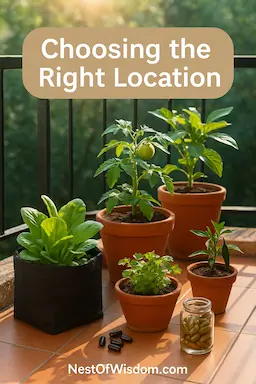

Even a small 3×3 ft balcony or sunny window ledge is enough to grow organic vegetables at home. Check these basics:
- Sunlight: Aim 4–6 hours (morning sun is gentler on leaves).
- Ventilation: Free airflow lowers disease and strengthens stems.
- Drainage: Keep trays/holes clear; protect floors with saucers.
- Safety: Secure railing planters; avoid heavy loads on weak rails.
Tip: Rotate pots weekly so all sides get light. A free light-meter app helps fine-tune placement.
🪴 Secret #2: Containers & a Proven Soil Mix
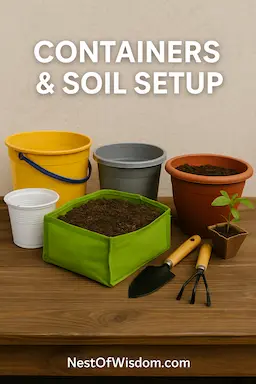

Use what you have — grow bags, buckets, or crates — but ensure food-safe materials and drainage holes. Match pot depth to crop (deep for tomatoes/chilies/curry leaf; shallow/wide for greens).
- Soil recipe: 40% red soil + 30% cocopeat + 30% mature compost
- Add-ins: A handful of neem cake or a pinch of wood ash per pot
- Texture & pH: Cocopeat keeps moisture; compost feeds microbes; soil adds structure
“உழவர் போல் வாழ்வோம் – நகரத்திலும் இயற்கையை வாழ்விப்போம்.”
(Live like a farmer — bring nature into city life.)
🧪 Secret #3: Natural Fertilizers & Safe Pest Control
Skip harsh chemicals. Follow a steady organic rhythm to grow organic vegetables at home with safer residue levels:
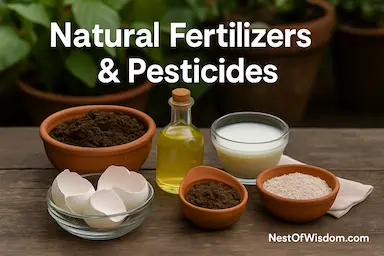

- Every 2 weeks: Compost tea or diluted vermiwash
- Monthly: Light top-dress of compost; water in well
- Trace minerals: Eggshell powder (calcium) + a pinch of wood ash (potash) for fruiting crops
Gentle pest care: 2–3% neem oil spray (with mild soap emulsifier) in the evening; garlic-chili extract weekly as preventive. Hand-pick pests early.
🌱 Secret #4: Watering, Drainage & Daily Plant Care
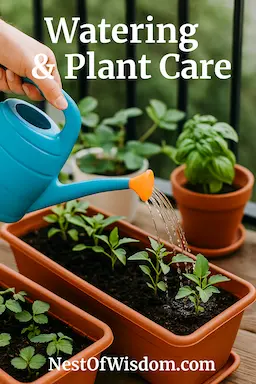

Timing: Early morning or evening watering reduces stress
Moisture: Keep soil moist, not soggy (finger test top 2–3 cm)
Drainage: Ensure holes are clear; empty standing water
Support: Stake tomatoes/okra; tie with soft cloth
Hygiene: Remove yellowed leaves; prune lightly for airflow
“தோட்டம் தினசரி கவனிப்பில் தான் வளர்ச்சி காணும்.” — tiny daily habits create healthier harvests.
💡 Secret #5: Smart Crop Selection & Companion Planting
Start with quick wins (spinach, coriander, mint). Add fruiting plants once you’ve mastered watering and feeding. Companion plant combos improve resilience and save space:
- Tomato + Basil: Flavor boost; basil may deter some pests.
- Chilies + Marigold: Marigold attracts beneficials and distracts pests.
- Spinach under Okra: Light shade helps greens in hotter months.
- Mint in its own tray: Contains spreading roots; harvest often.
Stagger sowings every 2–3 weeks so you continuously grow organic vegetables at home without gluts or gaps.
☀️ Secret #6: Sunlight Management & Seasonal Planning
Most vegetables prefer full sun (≥6 hrs). In peak heat, use 30–40% shade cloth at midday for tender greens. Plan by season:
- Cooler months: Leafy greens, coriander, peas
- Warmer months: Tomatoes, chilies, okra, cucumbers
- Year-round herbs: Mint, curry leaves (shelter in extremes)
Track your balcony’s microclimates — gentle morning light vs harsher afternoon sun — and place pots accordingly to grow organic vegetables at home consistently.
Following this simple calendar keeps chores light and helps you grow organic vegetables at home with less guesswork.
📐 Secret #7: Space Maximization – Vertical & Micro-Layouts
Use vertical racks, railing planters, and wall hooks. Group crops by height and water needs. A simple 3×5 ft balcony layout:
- Back row (tall): Tomatoes/okra in 12–14″ pots, well-staked
- Middle (medium): Chilies, curry leaves in 10–12″ pots
- Front (low): Spinach/coriander/mint trays for frequent harvest
Leave a small walkway for watering and pruning. With this layout you can grow organic vegetables at home efficiently without clutter.
🌱 Seed Starting & Transplanting (Beginner Basics)
For leafy greens (spinach, coriander, mint), sow directly in trays. For tomatoes and chilies, start seeds in a small nursery tray and transplant gently at the 3–4 true-leaf stage.
- Medium: 50% cocopeat + 50% compost; keep evenly moist
- Depth: Tiny seeds = very shallow; cover lightly
- Light: Bright shade until sprout; introduce sun gradually
- Transplant: Water the nursery and destination pot first; lift with soil attached; avoid root damage
Label sowing dates so you can refine timing and continuously grow organic vegetables at home all year.
🗓️ Weekly Micro-Schedule (Simple Care Calendar)
- Mon: Deep water; check drainage holes
- Tue: Leaf cleaning; rotate pots for even light
- Wed: Light feed (compost tea/vermiwash)
- Thu: Inspect for pests; hand-pick; neem spray if needed
- Fri: Prune lightly for airflow; remove yellowed leaves
- Sat: Harvest greens; sow a small new batch (succession)
- Sun: Top-dress compost if due; tidy tools and labels
This rhythm makes it easier to grow organic vegetables at home consistently, even with a busy schedule.
♻️ Low-Cost & Zero-Waste Hacks
- Reuse plastic buckets/crates as pots (drill holes at the base/sides)
- Collect dry leaves for mulch; reduce evaporation and weeds
- Compost kitchen scraps (tea dust, banana peels) to feed microbes
- Save seeds from coriander, chilies, and some tomatoes (heirloom types)
- Use rice-wash water (diluted) occasionally as a mild feed
“குறைந்த செலவில் உயர்ந்த தரம்” — simple habits help you grow organic vegetables at home without big spending.
🔁 Harvest, Storage & Regrow from Kitchen Scraps
- Cut-and-come-again: Harvest spinach leaves from the outside; let the center keep growing
- Soft herbs: Snip mint/coriander often; frequent cuts encourage branching
- Storage: Rinse, spin/dry, and refrigerate in breathable containers
- Regrow scraps: Spring onions, mint stems, and coriander roots can re-sprout in water, then pot up
These small cycles keep your balcony productive and make it more enjoyable to grow organic vegetables at home year-round.
🧰 Starter Checklist (One-Week Setup)
- Pick a spot with 4–6 hrs sun + airflow
- Get 4–6 containers: 2 deep, 2 medium, 2 shallow trays
- Make soil mix (40% soil, 30% cocopeat, 30% compost) + neem cake
- Sow easy greens first (spinach, coriander, mint); add tomatoes/chilies in week 2
- Set a weekly routine: feed (compost tea), prune, rotate pots, clean leaves
🚫 Common Mistakes to Avoid
- Overwatering: Roots suffocate; use the finger test
- Tiny pots for big crops: Deep containers for tomatoes/okra/curry leaves
- Skipping drainage: Always add holes; use a mesh to stop soil loss
- Too many crops at once: Start with 2–3, then scale up
- Ignoring sun path: Track light; shift pots seasonally
❓ FAQs
Can I really grow organic vegetables at home without land?
Yes. A small balcony or bright window with 4–6 hours of sun is enough. Use containers with drainage and a simple soil mix to grow organic vegetables at home successfully.
Which balcony vegetables are easiest for beginners?
Spinach, coriander, mint, and green chilies establish quickly. Add tomatoes and okra when you’re comfortable with watering and staking.
How often should I fertilize container vegetables?
Feed lightly every 2 weeks with compost tea or vermiwash; top-dress monthly with compost. This steady approach keeps leaves healthy without chemical spikes.
Do balcony gardens attract many pests?
Usually not if you maintain airflow and hygiene. Use neem oil sprays in the evening and try garlic-chili extract weekly as a natural deterrent.
What’s the best watering schedule for busy people?
Water deeply 2–3 times a week (season-dependent) rather than tiny daily sips. Mulch the surface to reduce evaporation.
🔗 Related Internal Guides
- Best Indoor Plants for Health, Wealth & Positive Energy
- Top 10 Sacred Plants for Vastu & Spiritual Energy
- 11 Best Companion Planting Tips for Beginners
- 20 Healing Foods for Common Illnesses
🌐 References
- Royal Horticultural Society — Vegetables in Containers (container depth & watering)
- University of Illinois Extension — How to Grow Fruits, Vegetables & Herbs in Containers
- FAO — Urban & Peri-urban Agriculture Sourcebook
- Cornell Cooperative Extension — Container Gardening
- TNAU/GoTN — DIY Terrace Garden Operational Manual
✅ Conclusion
When you grow organic vegetables at home, you gain more than food: you build calm, routine, and resilience for the whole family. Start with 2–3 easy crops, rotate pots for sun, and nurture soil life with compost and gentle feeds. With a few weekly habits — pruning, cleaning leaves, and mindful watering — your balcony becomes a living classroom for health and sustainability. “சிறு முயற்சி, பெரிய மகசூல்.” Your green corner can begin today.
Nest of Wisdom Insights is a dedicated editorial team focused on sharing timeless wisdom, natural healing remedies, spiritual practices, and practical life strategies. Our mission is to empower readers with trustworthy, well-researched guidance rooted in both Tamil culture and modern science.
இயற்கை வாழ்வு மற்றும் ஆன்மிகம் சார்ந்த அறிவு அனைவருக்கும் பயனளிக்க வேண்டும் என்பதே எங்கள் நோக்கம்.
- Nest of Wisdom Insightshttps://nestofwisdom.com/author/nestofwisdom/
- Nest of Wisdom Insightshttps://nestofwisdom.com/author/nestofwisdom/
- Nest of Wisdom Insightshttps://nestofwisdom.com/author/nestofwisdom/
- Nest of Wisdom Insightshttps://nestofwisdom.com/author/nestofwisdom/
Related posts
Today's pick
Recent Posts
- Internal Linking Strategy for Blogs: A Practical, Human-Centered Playbook
- AI in the Automotive Industry: A Practical, Human-Centered Guide
- Cloud Tools for Small Businesses and Freelancers: The Complete Guide
- Generative AI in Business: Real-World Use Cases, Benefits & Risks
- 7 Life-Changing Daily Habits for Weight Loss Without Dieting

